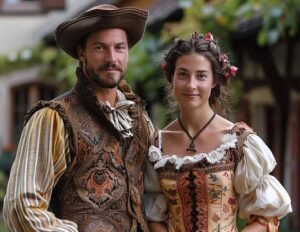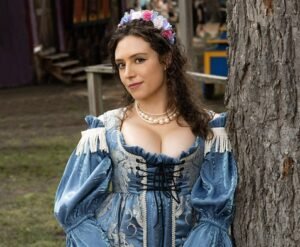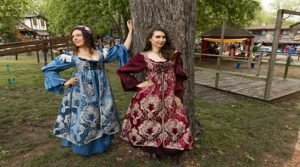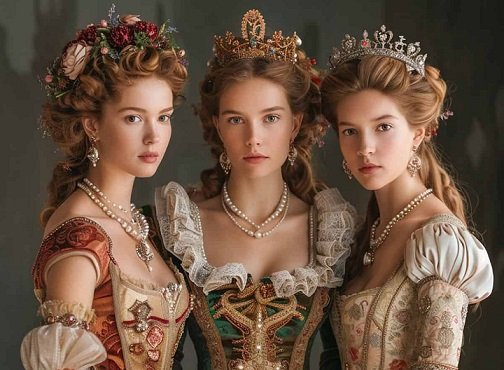Renaissance Fashion for Women: A Deep Dive into the Elegance and Trends of the Era
The Renaissance period, spanning roughly from the 14th to the 17th century, was a time of incredible cultural transformation. It marked the end of the Middle Ages and the beginning of the modern world, bringing with it groundbreaking advancements in art, science, and philosophy. One of the most notable aspects of this era was its fashion. Renaissance Fashion for Women was extravagant, sophisticated, and full of symbolism, influenced by the social, political, and economic changes of the time. This era gave rise to an elegant and opulent style of dressing, which still resonates in today’s high-fashion world.
In this blog post, we will explore the details of Renaissance fashion for women, highlighting key trends, styles, fabrics, and how these elements continue to shape modern fashion. We will also look at the role of fashion in society during the Renaissance and its influence on the women of the time.
Table of Contents
- What Was Renaissance Fashion for Women?
- Key Elements of Renaissance Fashion
- 2.1 Fabrics and Materials
- 2.2 Colors and Dyeing Techniques
- 2.3 Silhouettes and Fits
- Iconic Renaissance Fashion Trends for Women
- 3.1 The Gown
- 3.2 Corsetry and Bodices
- 3.3 The Farthingale
- 3.4 Sleeves and Necklines
- 3.5 Headwear and Accessories
- Renaissance Fashion for Women in Different Regions
- 4.1 Italian Renaissance Fashion
- 4.2 French Renaissance Fashion
- 4.3 English Renaissance Fashion
- The Influence of Renaissance Fashion on Modern Fashion
- Fashion and Social Class during the Renaissance
- Famous Women of the Renaissance and Their Fashion
- How Renaissance Fashion Influences Modern Haute Couture
- DIY Renaissance-Inspired Fashion for Women
- Where to See Renaissance Fashion Today
- Renaissance Fashion FAQ
- Conclusion
- Disclaimer
1. What Was Renaissance Fashion for Women?

Renaissance fashion was characterized by a dramatic shift in the way people dressed. Gone were the rigid, modest styles of the medieval period, and in their place came clothing that celebrated the beauty of the human body, rich fabrics, and intricate designs. Women during the Renaissance wore garments that were both ornate and symbolic, designed to highlight social status, wealth, and femininity.
Renaissance fashion for women was defined by a combination of elaborate gowns, decorative bodices, flowing sleeves, and accessories. Women in the upper classes wore clothing that was meant to showcase their family’s wealth and social position, while those in the lower classes had more practical, simple attire. However, fashion during this time was still an essential part of society, even for commoners.
2. Key Elements of Renaissance Fashion
2.1 Fabrics and Materials
Fabrics played a significant role in Renaissance fashion. Wealthy women had access to luxurious materials, while those from lower social classes wore simpler fabrics. The most commonly used fabrics during the Renaissance included:
- Silk: Silks were highly prized and used for gowns and bodices.
- Velvet: Velvet was another luxurious fabric used for its rich texture and depth.
- Brocade: Often intricately woven with gold or silver threads, brocade was used for formal dresses.
- Linen: Linen was often used for undergarments or simpler clothing, particularly for common folk.
- Wool: Wool was more affordable and was used by the middle and lower classes for outer garments.
2.2 Colors and Dyeing Techniques
The Renaissance period saw an explosion of color in fashion, with vibrant and bold hues becoming popular among the elite. Dyeing techniques had improved, which meant that a greater variety of colors could be achieved. Some of the most popular colors during this time included:
- Red: Symbolized wealth and power, often used for gowns and cloaks.
- Blue: Associated with royalty and spirituality.
- Gold: A color of opulence and wealth, often incorporated into fabrics like brocade.
- Green: Represented fertility and was a popular choice for both the elite and middle classes.
| Color | Symbolism/Meaning | Fabric Use |
|---|---|---|
| Red | Wealth, power | Gowns, cloaks |
| Blue | Royalty, spirituality | Gowns, tunics |
| Gold | Opulence, wealth | Brocade, trims |
| Green | Fertility, youth | Gowns, everyday wear |
2.3 Silhouettes and Fits
The silhouette of Renaissance fashion for women was designed to accentuate the body. The clothing typically featured fitted bodices, wide skirts, and large sleeves. The corset was an essential garment that helped create an hourglass shape, a figure idealized during this period. Women wore layers, and the clothing fit tightly at the waist, flowing out into a fuller skirt or gown.
The use of undergarments such as chemises and petticoats was common, as they provided support for the outer layers and helped shape the figure.
3. Iconic Renaissance Fashion Trends for Women

Several key trends defined Renaissance fashion for women, and they have influenced the fashion world for centuries. Here are some of the most iconic elements of Renaissance fashion:
3.1 The Gown
The gown was the most common garment for women during the Renaissance. Typically, it was a long, flowing garment made from luxurious fabrics such as velvet or brocade, adorned with intricate details. The gown’s design evolved throughout the period, with high collars, plunging necklines, and wide sleeves becoming popular.
3.2 Corsetry and Bodices
The bodice was an essential part of Renaissance fashion for women. It was a tightly fitting garment that accentuated the waist and bust, often made from stiffened fabric or leather. The corset, which became a hallmark of Western fashion, was worn underneath the bodice to provide additional structure.
3.3 The Farthingale
The farthingale was a hoop skirt worn beneath the gown to give it a conical shape. This garment was crucial in achieving the full, voluminous look that was popular during the Renaissance. It was made from whalebone, steel, or wood and was used to support the wide skirts that were fashionable at the time.
3.4 Sleeves and Necklines
Sleeves were an important feature of Renaissance fashion, often elaborately decorated with embroidery, lace, or jewels. They were sometimes detachable, allowing for different looks. Necklines ranged from high collars to low, square cuts that exposed the chest and neck.
3.5 Headwear and Accessories
Headwear was an essential part of Renaissance fashion. Women often wore elaborate headdresses, such as:
- Hoods: Soft, close-fitting coverings for the head.
- Veils: Worn by women of higher social status, veils were a symbol of modesty.
- Caps and Bonnets: Some women wore caps adorned with ribbons, lace, or jewels.
- Jewelry: Pearls, diamonds, and gold were popular choices for jewelry during the Renaissance, symbolizing wealth and power.
4. Renaissance Fashion for Women in Different Regions
Fashion during the Renaissance varied across regions, reflecting the culture, economy, and climate of each area.
4.1 Italian Renaissance Fashion
Italian Renaissance fashion was characterized by its intricate designs and luxurious fabrics. Florence, Milan, and Venice were centers of fashion, and the clothing worn by Italian women often featured sumptuous fabrics like silk, velvet, and brocade. Wealthy women wore gowns with tight bodices, large skirts, and elaborate decorations.
4.2 French Renaissance Fashion
French Renaissance fashion was heavily influenced by the royal court. The French court’s lavishness set trends for the entire nation, with women wearing gowns that featured pointed bodices, long flowing sleeves, and elaborate embroidery. French women also wore “French hoods,” a type of headdress that became iconic during the period.
4.3 English Renaissance Fashion
English Renaissance fashion was more restrained compared to Italian and French styles, but it still featured ornate garments. Queen Elizabeth I’s reign was particularly influential, with women wearing gowns that had high collars, intricate ruffs, and puffed sleeves. The English court was known for its use of rich colors, particularly red and gold.
5. The Influence of Renaissance Fashion on Modern Fashion

The influence of Renaissance fashion can be seen in today’s haute couture collections, where designers often draw inspiration from the opulent gowns, intricate detailing, and rich fabrics of the era. Elements like corsetry, voluminous skirts, and elaborate sleeves are often reimagined in modern ways.
Designers such as Vivienne Westwood and Alexander McQueen have taken cues from Renaissance silhouettes, incorporating the dramatic shapes and bold colors of the time into their collections. Renaissance fashion continues to inspire modern fashion trends, particularly in the realm of evening wear and bridal fashion.
6. Fashion and Social Class during the Renaissance
Fashion was deeply tied to social class during the Renaissance. The elite wore extravagant garments made from expensive fabrics, while lower-class women had more modest clothing. The wealthy could afford the time-consuming process of creating intricate gowns, while poorer women wore simpler styles. Fashion was a visible marker of one’s social status, and it reflected both wealth and personal taste.
7. Famous Women of the Renaissance and Their Fashion
Several famous women from the Renaissance period left a lasting legacy on fashion. Here are a few notable figures:
- Catherine de Medici: Known for her influence on French fashion, Catherine introduced new styles such as the Italian Renaissance gown to the French court.
- Queen Elizabeth I: Elizabeth I’s wardrobe became legendary, and she popularized the high-necked, voluminous dresses and elaborate ruffs that defined her reign.
- Isabella d’Este: An influential Italian noblewoman, Isabella was known for her sophisticated and luxurious clothing choices.
8. How Renaissance Fashion Influences Modern Haute Couture
Renaissance fashion has had a lasting impact on haute couture, with many modern designers drawing inspiration from the period’s elaborate style. The use of luxurious fabrics, dramatic silhouettes, and intricate detailing can be traced back to Renaissance gowns. Fashion houses like Valentino, Dior, and Chanel have looked to the Renaissance for inspiration when designing their runway collections, often incorporating Renaissance elements such as ruffles, corsets, and voluminous skirts into their designs.
9. DIY Renaissance-Inspired Fashion for Women
If you are looking to add some Renaissance-inspired pieces to your wardrobe, here are a few DIY ideas:
- Corset Dresses: Create a simple dress with a corset top and flowy skirt.
- Flowing Sleeves: Add dramatic, wide sleeves to your current wardrobe with a bit of DIY sewing.
- Embellishments: Embellish your outfits with lace, ribbons, or faux pearls to mimic the Renaissance style.
10. Where to See Renaissance Fashion Today
You can experience Renaissance fashion in a variety of places:
- Museums: Many art museums feature Renaissance paintings that showcase the fashion of the time.
- Historical Reenactments: Renaissance fairs and historical reenactments often feature authentic Renaissance attire.
- Fashion Exhibitions: Some fashion exhibitions focus on the history of clothing and may include Renaissance-inspired collections.
11. Renaissance Fashion FAQ
Q1. What was the most important element of Renaissance fashion for women?
The most important element was the use of luxurious fabrics like velvet, silk, and brocade, as well as the structured bodices that accentuated the waist.
Q2. How did Renaissance fashion differ across regions?
Fashion differed depending on the region, with Italian, French, and English styles each having their own unique elements and influences.
12. Conclusion
Renaissance fashion for women was a magnificent celebration of beauty, wealth, and social status. From intricate gowns to lavish accessories, this period of fashion laid the foundation for many of the styles we see in modern haute couture. Whether you are a history buff, a fashion enthusiast, or simply someone who appreciates elegance, the fashion of the Renaissance continues to captivate and inspire.
13. Disclaimer
The information provided in this blog post is based on historical sources and general knowledge. Fashion styles and trends may vary depending on different sources, and this article serves as an overview of Renaissance fashion for women. For more accurate and detailed information, refer to fashion history books and reputable sources in the field.
